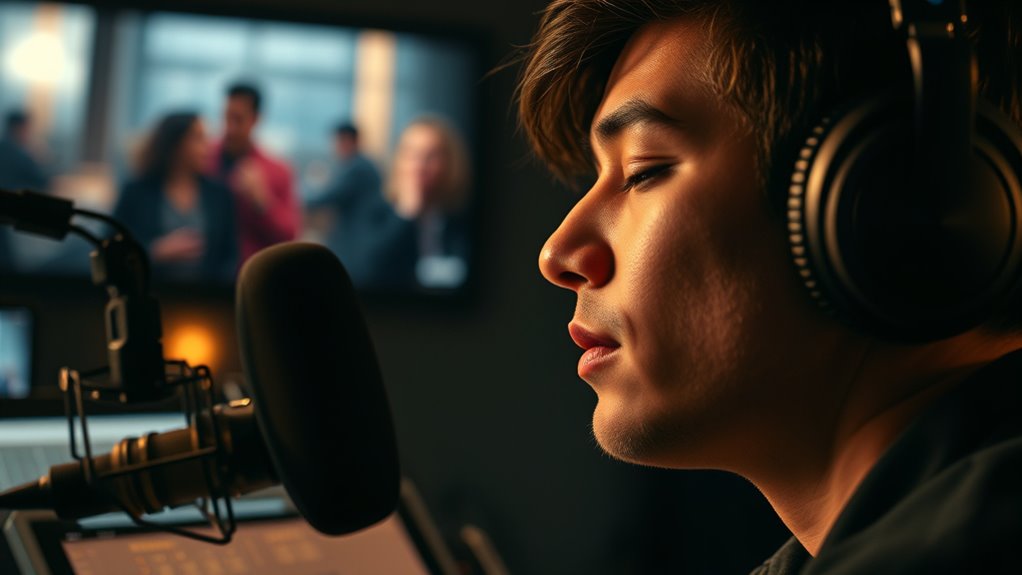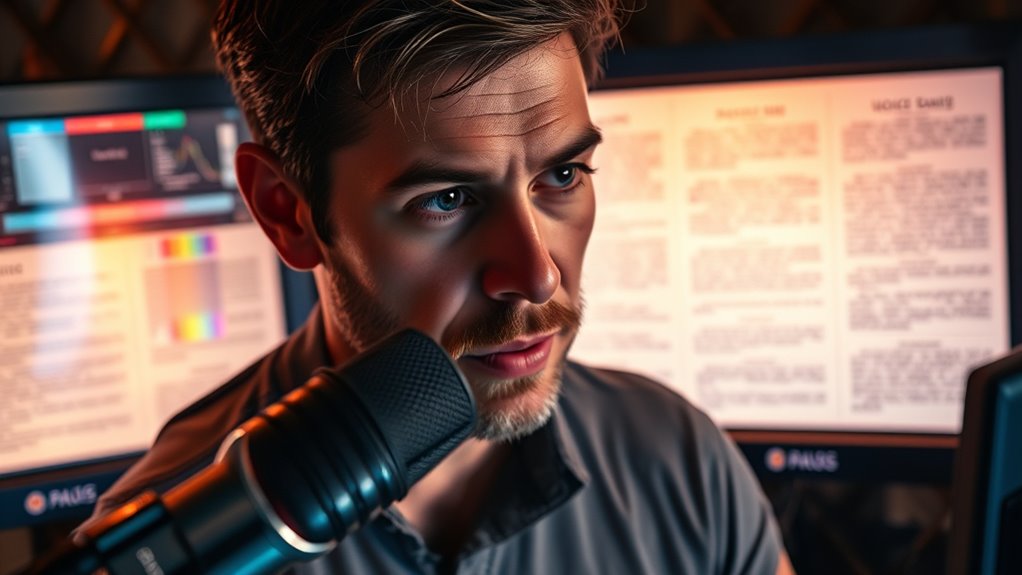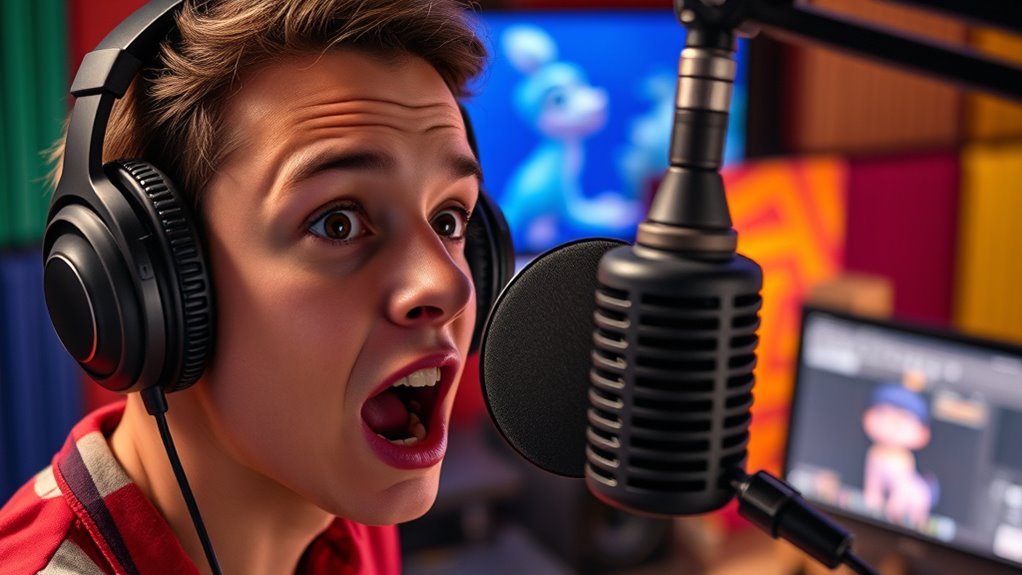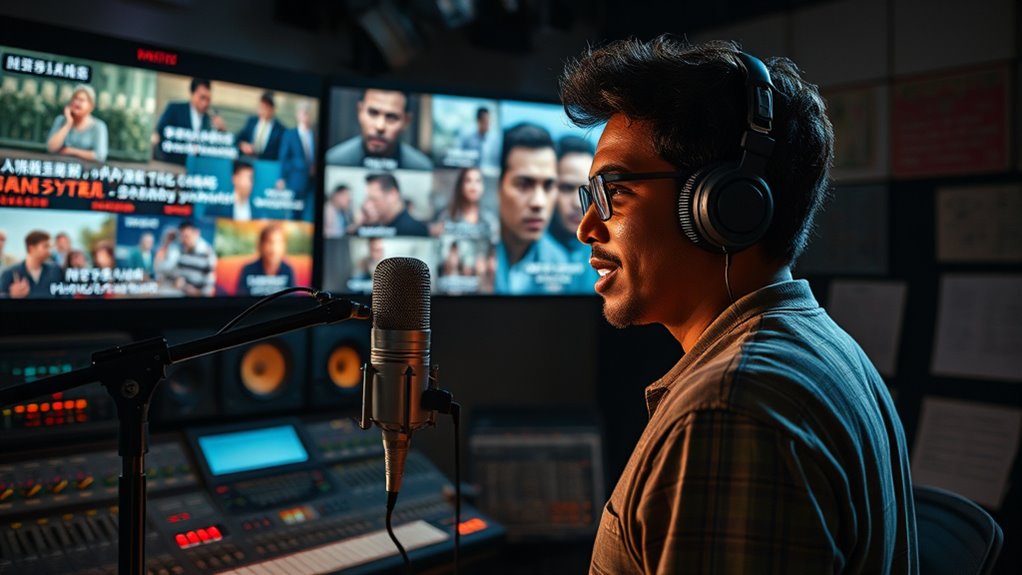Voice acting shapes the movies you love by creating memorable characters, adding emotional depth, and building immersive worlds that draw you in. Your favorite voices evoke personality, stereotypes, and feelings that make stories believable and compelling. They support visual effects, enhance soundtracks, and even give life to non-human characters. Skilled voice actors leave lasting impressions that define a film’s tone and impact. Discover how this art form influences every aspect of your favorite movies as you continue exploring.
Key Takeaways
- Distinctive voices create memorable characters that become cultural icons, enhancing movie recognition and audience loyalty.
- Voice modulation conveys deep emotions and nuances, adding authenticity and emotional depth to storytelling.
- Voice actors’ performances influence audience perceptions of character personality, background, and societal stereotypes.
- Well-designed vocal traits support immersive worlds and atmospheres, enriching the film’s realism and emotional impact.
- Iconic voice performances can elevate a film’s popularity, franchise longevity, and cultural significance.
Creating Unforgettable Character Identities

Have you ever wondered what makes a voice actor’s performance truly memorable? It starts with your ability to create a distinct character identity. During voice actor auditions, casting directors look for voices that stand out and match the character’s personality. To do that, you need solid vocal training techniques—working on pitch, tone, and diction—that help shape your unique voice. Practice crafting a consistent vocal style that captures the character’s traits, whether it’s warmth, authority, or quirkiness. Developing this identity isn’t just about sounding different; it’s about embodying the character fully. The more you refine your vocal skills, the better you can bring characters to life, making your performances unforgettable to audiences. Additionally, understanding how vetted products are designed for durability and safety can inspire confidence in your vocal confidence and authenticity.
Enhancing Emotional Depth and Authenticity

To truly captivate your audience, you need to infuse your voice acting with genuine emotion and authenticity. Your dialogue delivery plays a pivotal role in creating emotional resonance that connects viewers to the story. When you express vulnerability, joy, or despair convincingly, it deepens the audience’s engagement and makes scenes more impactful. Subtle variations in tone, pitch, and pacing help convey complex feelings and add layers to your character’s personality. Authentic voice acting transforms simple lines into heartfelt moments that resonate long after the scene ends. By focusing on emotional depth, you enable viewers to empathize with your character’s journey, making the story more compelling and memorable. Incorporating emotional impact techniques can elevate your performances and truly connect with your audience on a deeper level. Ultimately, your genuine performance elevates the entire cinematic experience.
Building Immersive World-Building Atmospheres

You can create immersive worlds by designing authentic environments that feel real and lived-in. Enhancing sensory depth through voice work helps audiences experience the atmosphere more vividly. Crafting distinct character voices further brings these worlds to life, making every scene more convincing. Utilizing sound effects and ambient sounds effectively can significantly deepen the realism of the environment.
Creating Authentic Environments
Creating authentic environments in voice acting involves more than just reading lines; it requires immersing yourself in the world you’re representing. Your dialogue delivery must match the setting’s mood, tone, and atmosphere. Use sound design techniques like reverberation, ambient noise, and layered effects to deepen the scene’s realism. Imagine these elements shaping your environment:
| Setting | Sound Elements | Atmosphere |
|---|---|---|
| Rainy city street | Distant sirens, footsteps, rain | Gritty, tense |
| Cozy cabin | Crackling fire, wind outside | Warm, intimate |
| Busy marketplace | Chatter, horses, shop bells | Hustling, lively |
| Quiet library | Pages turning, hushed whispers | Calm, contemplative |
Mastering these techniques guarantees your voice transforms the scene into a believable, immersive world.
Enhancing Sensory Depth
Enhancing sensory depth involves carefully layering sounds and details that engage multiple senses, making scenes feel more vivid and immersive. Your voice acting, especially through effective dialogue delivery and vocal modulation, plays a key role in creating this atmosphere. By varying tone, pitch, and pace, you can evoke specific emotions and environments. To deepen immersion, consider these techniques:
- Use subtle background sounds that complement the scene’s mood.
- Adjust vocal modulation to reflect character surroundings and emotional states.
- Employ precise dialogue delivery that emphasizes important sensory cues.
These methods make viewers feel present, as if they’re experiencing the world firsthand. When executed well, your voice can transform simple scenes into rich, multi-sensory experiences that heighten audience engagement.
Crafting Character Voices
Building distinct character voices is essential for immersing audiences in a believable world. Your dialogue delivery brings authenticity and personality to each character, making their interactions feel genuine. Voice modulation helps you convey emotions, mood, and nuances that deepen the audience’s connection. By varying pitch, tone, and pace, you create memorable voices that stand out and enhance the story’s atmosphere. Whether voicing a brave hero or a sinister villain, your ability to adjust these elements makes characters more relatable and vivid. Crafting unique voices requires careful attention to how words are spoken, not just what’s said. When done well, your voice becomes a crucial tool in building immersive, emotionally charged worlds that draw viewers in and keep them captivated.
Giving Voice to Non-Human Characters

Giving voice to non-human characters requires a unique blend of creativity and technical skill. You must transform robotic dialogue or animal vocalizations into convincing personalities that resonate with audiences. To achieve this, consider these key techniques:
- Use expressive tone modulation to convey emotions beyond words, making robotic dialogue feel alive.
- Layer animal vocalizations with subtle modifications, creating distinctive sounds that capture character traits.
- Balance naturalistic sounds with exaggerated effects to enhance believability and emotional impact.
- Incorporate knowledge of anime films to inform voice choices that complement diverse storytelling styles and genres.
Conveying Subtle Nuances and Complexities

Capturing subtle nuances and complex emotions in voice acting requires more than just clear diction; it demands an attentive ear and an ability to convey unspoken feelings through tone and timing. You need to master vocal subtleties that reveal underlying emotions, even when the dialogue is minimal. Skilled voice actors use slight shifts in pitch, volume, and pace to express emotional complexity, allowing you to sense the character’s inner struggles or joy without explicit words. These nuanced vocal choices deepen the authenticity of a performance, making characters more relatable and layered. When done well, this subtlety draws you into the story, creating a richer, more immersive experience. It’s these small but powerful details that elevate a film from good to unforgettable. Developing an ear for these vocal subtleties can greatly enhance the emotional impact of a performance.
Influencing Audience Perception and Biases

Your perception of a character is heavily shaped by their voice tone and the trust it builds. Vocal cues can subtly influence your biases, making you see characters in a certain light. By understanding these vocal techniques, you can recognize how voice acting guides your overall movie experience. Additionally, awareness of AI vulnerabilities can help viewers stay critical of AI-generated content and voice performances.
Voice Tone and Trust
Have you ever wondered how a voice’s tone can shape your trust in a character or narrator? Your perception of trustworthiness hinges heavily on subtle cues in voice tone. A warm, steady voice often signals reliability, making you more likely to believe what’s being said. Conversely, a harsh or uncertain tone can raise doubts, even if the words are positive. Consider these key points:
- Consistent tone enhances perceived trustworthiness, reinforcing credibility.
- Variations in pitch and pace can either build rapport or suggest deception.
- Calm, confident voices tend to foster emotional safety, increasing your trust.
Your subconscious picks up on these cues, influencing how much you trust or doubt the characters on screen without even realizing it. Voice tone subtly guides your biases and perceptions, shaping your overall movie experience.
Character Perception Shaping
Voice acting plays a crucial role in shaping how you perceive characters and form biases about them. The voice creates a voice identity that signals personality traits, influencing your initial impressions. For example, a deep, commanding voice might make a character seem authoritative, while a soft, high-pitched voice could suggest innocence or vulnerability. Your brain quickly associates these vocal cues with traits, affecting your expectations and judgments.
| Voice Trait | Perceived Personality | Example Character Trait |
|---|---|---|
| Deep, resonant | Authority, strength | Leader or villain |
| Soft, gentle | Kindness, naivety | Innocent or caring |
| Sharp, harsh | Aggressiveness | Antagonist or rival |
| Warm, friendly | Trustworthy, approachable | Sidekick or hero |
| Nasal, high-pitched | Nervousness, youth | Comic relief or young |
Your perception is shaped by how these voice identities evoke specific personality traits.
Biases Through Vocal Cues
Vocal cues can subtly influence your perceptions and reinforce biases about characters, often without you realizing it. These cues tap into vocal stereotypes and cultural biases, shaping how you judge characters’ personalities and backgrounds. For example, a deep, commanding voice might lead you to see a character as authoritative or intimidating, while a high-pitched voice could evoke innocence or naivety. These associations are often rooted in societal norms and stereotypes that influence your subconscious. To understand this, consider:
- How vocal stereotypes assign traits based on tone, pitch, or accent.
- How cultural biases influence your perception of a character’s background through voice.
- How voice actors unintentionally reinforce or challenge these biases, impacting your overall bias toward characters.
Supporting Visual Effects and Animation

Supporting visual effects and animation play a crucial role in bringing animated characters and fantastical worlds to life, seamlessly blending voice performances with stunning imagery. The key is in voice actor selection, guaranteeing the voice matches the character’s personality and enhances the visual storytelling. When done well, it creates a believable connection between the audience and the animated world. Sound design integration further amplifies this effect by adding depth and realism, making scenes more immersive. Carefully synchronized voice acting with visual effects ensures emotions come across clearly, whether it’s humor, tension, or wonder. Your experience becomes richer as the combination of expressive voices and compelling visuals guides your emotional journey through the story, making it feel vibrant and authentic. Embracing the principles of resilience in voice acting can also help performers deliver more authentic and emotionally resonant performances, further strengthening the connection with viewers.
Shaping Memorable Soundtracks and Themes

You can create unforgettable soundtracks by crafting melodies that stick with your audience long after the movie ends. These tunes not only define the film’s identity but also deepen the emotional experience for viewers. When done well, your themes become powerful tools to evoke feelings and enhance storytelling. Additionally, incorporating distinctive sound design elements can further elevate the cinematic experience by complementing the musical score and reinforcing the film’s mood.
Crafting Iconic Melodies
Crafting an iconic melody requires a deep understanding of the story and the emotions it aims to evoke. You need to focus on musical storytelling, creating melodies that resonate with viewers long after the credits roll. Melodic motifs serve as memorable signatures, reinforcing characters or themes throughout the film. To achieve this, consider these key elements:
- Develop simple, recognizable motifs that can be transformed or repeated.
- Align melodies with emotional beats, heightening viewer engagement.
- Use variations to maintain interest while preserving core themes.
Enhancing Emotional Depth
Building on the power of melodic motifs, shaping emotional depth in a soundtrack involves carefully selecting and manipulating musical elements to evoke specific feelings. Your voice actors’ dialogue delivery plays a crucial role here, as their tone and timing can heighten emotional resonance, making scenes more impactful. When dialogue feels authentic and heartfelt, it amplifies the music’s effect, drawing you deeper into the story. The synergy between voice performance and soundtrack creates a layered emotional experience, turning simple melodies into memorable themes. By aligning musical cues with the nuances of dialogue delivery, filmmakers evoke genuine emotions—whether joy, despair, or hope—transforming the soundtrack into a vital tool for emotional storytelling. This integration makes the movie’s emotional depth resonate long after the credits roll.
Enabling Multilingual and International Films

How does voice acting facilitate the success of multilingual and international films? It enhances language accessibility and cultural translation, making films understandable and relatable across diverse audiences. Voice actors provide authentic performances that resonate with local cultures, preserving nuances often lost in subtitles. This process guarantees viewers connect emotionally, regardless of language barriers. Moreover, leveraging plain-English communication techniques in voice performances can improve overall viewer comprehension and engagement. Consider these key contributions:
Voice acting bridges language gaps, preserving cultural nuances and fostering emotional connections worldwide.
- They enable seamless dubbing, allowing audiences to enjoy films in their native language.
- They preserve cultural context, ensuring jokes, idioms, and expressions retain their original flavor.
- They help expand global reach, making movies more accessible and increasing international box office success.
Inspiring Iconic Voice Actor Performances

Iconic voice actor performances have the power to elevate animated characters to cultural icons, leaving a lasting impact on audiences worldwide. Your favorite characters come alive through vocal versatility, allowing actors to switch tones, emotions, and styles seamlessly. When a voice actor masters accent authenticity, it adds depth and realism, making characters more believable and memorable. Think of how certain voices instantly evoke a sense of place or personality, shaping how you perceive the story. These performances inspire audiences and fellow artists alike, demonstrating how a well-executed voice can define a character’s legacy. Whether it’s a villain’s menacing tone or a hero’s uplifting voice, these performances leave an indelible mark, proving that voice acting isn’t just about sound—it’s about creating lasting cultural icons. Additionally, understanding the importance of legal representation in voice acting contracts can help protect artists’ rights and ensure fair compensation.
Frequently Asked Questions
How Does Voice Acting Influence a Character’S Cultural Identity?
You might think voice acting doesn’t impact cultural identity, but it actually plays a key role. Skilled voice actors bring cultural authenticity and linguistic diversity to characters, making them more believable and relatable. By accurately representing accents, dialects, and speech patterns, they help preserve cultural nuances. This deepens your connection to the story, making the character’s cultural identity feel genuine and respectful, enriching your overall movie experience.
What Role Does Voice Modulation Play in Conveying Character Personality?
Voice modulation plays a vital role in conveying a character’s personality by allowing you to express emotion effectively. Through tone modulation, you can adapt your voice to show excitement, anger, or sadness, making the character more believable. Your ability to modulate your voice helps viewers understand the character’s inner feelings and intentions, creating a stronger emotional connection. Mastering emotion expression through voice modulation truly brings characters to life on screen.
How Do Voice Actors Adapt Performances for Different Target Audiences?
Did you know that 78% of viewers feel more connected to a story when voice actors adapt performances for their target audience? You see, voice actors tailor their delivery, tone, and language to enhance audience engagement. They adjust performances for kids, teens, or adults, making characters more relatable. This performance adaptation guarantees the movie resonates deeply, keeping you emotionally invested and making your movie experience unforgettable.
In What Ways Does Voice Acting Impact the Marketing of a Film?
You see how voice acting influences a film’s marketing by boosting merchandise branding and social media campaigns. When a voice actor creates a memorable character, it enhances promotional efforts, making merchandise more appealing and shareable online. Their unique voices help generate buzz, encouraging fans to engage with the film through clips, memes, and exclusive content, ultimately driving ticket sales and brand loyalty. Voice actors truly shape how movies connect with audiences beyond the screen.
How Has Technology Changed the Art of Voice Acting Over Time?
Technology has transformed voice acting through animation evolution and voice recording advancements. You now experience more realistic and expressive characters thanks to high-quality digital tools and sophisticated animation techniques. Voice recording has become more flexible with remote sessions and precise editing, allowing you to enjoy more nuanced performances. These innovations help voice actors deliver authentic emotions, making movies more immersive and enthralling for you.
Conclusion
Just like a voice actor’s performance can turn a simple character into a legend, their craft shapes the movies you love in surprising ways. Think of voice acting as the secret ingredient in a recipe—without it, the dish feels incomplete. When you watch your favorite films, remember it’s the subtle nuances and heartfelt voices that breathe life into every scene, transforming stories into unforgettable experiences. Voice acting truly is the soul behind the scenes.









